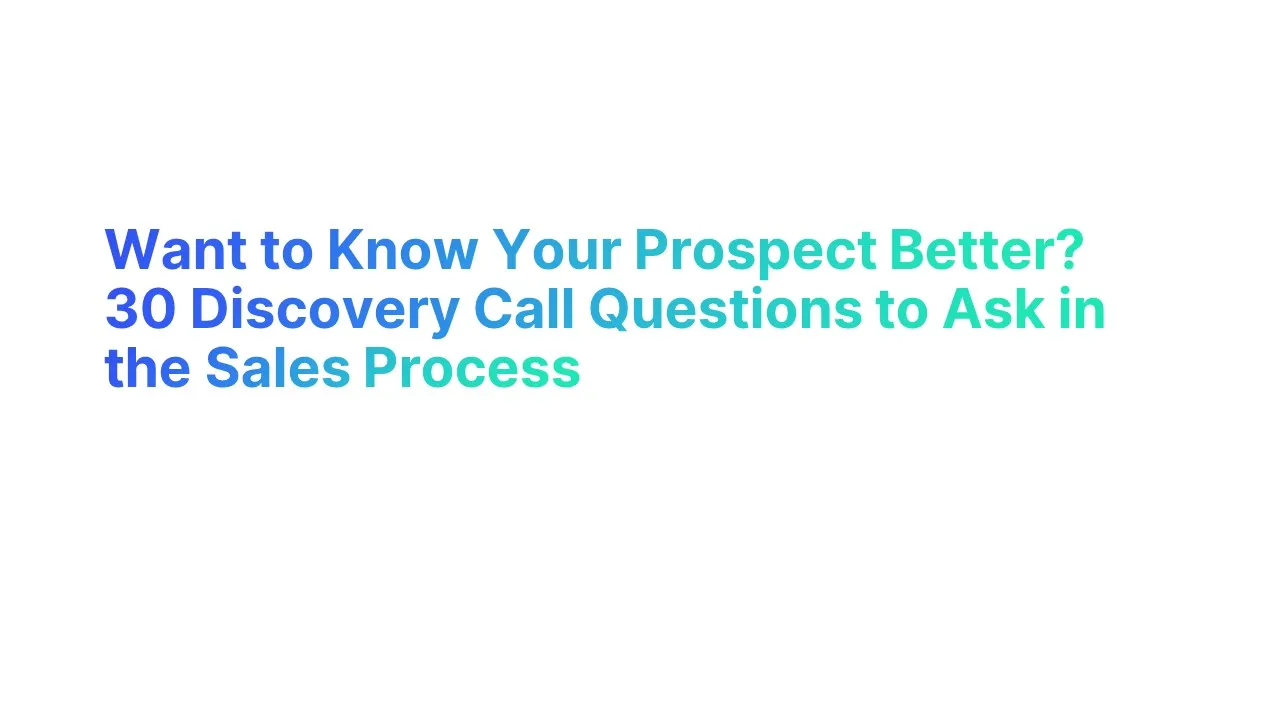Introduction to Discovery Calls

What is a Discovery Call
A discovery call is an initial conversation between a sales representative and a potential client. Its primary purpose is to gather information about the prospect's needs, challenges, and goals to assess whether the services or products offered can provide a valuable solution.
This call sets the stage for all future interactions in the sales process and helps both parties determine if there's a good fit worth pursuing further.
Objectives of a Discovery Call
The primary objectives of a discovery call are:
- Information Gathering: Collect detailed information on the prospect’s needs, challenges, and goals.
- Lead Qualification: Assess the prospect's fit based on need, budget, authority, and timing.
- Rapport Building: Establish a connection and trust between the sales representative and the prospect.
- Decision Maker Identification: Determine who makes decisions and understand the decision-making process.
- Sales Pitch Setup: Lay the groundwork for a tailored sales pitch based on the collected insights.
Why Are Discovery Calls Important

Discovery calls are crucial in the sales process because they lay the foundation for a successful customer relationship and streamline the sales journey. They ensure both the sales team and the potential customer invest their time wisely by verifying early on if there's a promising fit.
Key Reasons Discovery Calls Are Important:
1. Efficient Qualification
- Immediate Needs: Quickly assess if the prospect's needs align with the services or products offered.
- Budget Fit: Determine if the prospect's budget matches the pricing framework of the product or service.
2. Builds Relationships
- Trust Building: Establish trust by showing genuine interest in understanding and solving the prospect's challenges.
- Communication Channels: Open effective lines of communication, setting a positive tone for future interactions.
3. Guides Sales Strategy
- Customized Approaches: Allows sales teams to tailor their sales strategies based on the specific needs and pain points of the prospect.
- Focus on Value: Highlight how the product or service can uniquely address the prospect's particular issues.
4. Saves Time and Resources
- Prioritization: Helps prioritize leads, focusing time and resources on prospects with the highest potential for conversion.
- Avoids Pitfalls: Reduces the likelihood of pursuing unqualified leads, which can drain resources and demoralize sales teams.
Here are some key statistics related to sales discovery calls that highlight their impact and importance in the sales process:
- Call Length: Successful discovery calls typically last between 30 to 45 minutes, allowing sufficient time to gather detailed information and build rapport.
- Lead Qualification: Approximately 50-60% of the prospects admitted to being ready to discuss solutions during a discovery call, indicating its effectiveness in qualifying leads.
- Increased Conversion: Effective discovery calls can increase conversion rates by up to 70%, as they help tailor the sales approach to meet the specific needs of the prospect.
- Follow-Up: Around 40-50% of sales reps never follow up with a customer after the initial contact, yet following up after a discovery call can increase the chances of a sale by 20-30%.
- Question Count: The average successful discovery call includes between 11 to 14 questions, demonstrating the importance of engaging the prospect in a meaningful conversation.
- Training Impact: Teams that receive regular training on discovery call techniques see a 40% improvement in achieving their sales targets.
30 Best Discovery Call Questions to Assess Prospect Fit

Discovery call categories help sales representatives understand the prospect's needs, challenges, and the potential for a successful partnership. Here are the common types:
Rapport-Building Questions
These questions help establish a connection and make the prospect feel comfortable. Examples include inquiries about the prospect's business role or recent company news.
"Can you tell me a bit about your journey to your current role?"
- Effectiveness: This question invites the prospect to share their professional background and personal insights, which not only provides context about their experience and expertise but also helps the salesperson understand their career motivations and values.
- How It Works: It shows genuine interest in the person, not just the deal, helping to establish a personal connection that can lead to more open and honest communication.
"I noticed your company recently [mention a recent achievement or news]. Can you share more about this?"
- Effectiveness: Acknowledging a company’s recent achievements demonstrates that you have taken the time to research and understand their current successes and challenges. It flatters the prospect and shows that you view them as a noteworthy entity.
- How It Works: This question helps transition the discussion from casual small talk to business matters smoothly, bridging personal attention with professional interests.
"What’s the biggest change you’ve seen in your industry, and how has it impacted you?"
- Effectiveness: This question taps into the prospect's industry expertise and views, encouraging them to share their insights and perspective on broader trends.
- How It Works: It positions the salesperson as someone who values the prospect’s opinion, enhancing the prospect's comfort and willingness to engage further. It also provides valuable context about how external changes are affecting their business needs.
"Outside of work, what are you passionate about?"
- Effectiveness: This question helps break down formal barriers and reveals the human side of business interactions. Knowing a prospect's interests outside of work can reveal new ways to relate to them and find common ground.
- How It Works: Personal connections can strengthen business relationships. By finding shared interests, a salesperson can create more memorable interactions and foster goodwill that might prove advantageous in more formal negotiations.
Needs Discovery Questions
These are aimed at uncovering the prospect's specific needs and requirements. For instance, asking what challenges they are currently facing with their existing solutions.
"What are the top challenges you're facing in your current operations?"
- Effectiveness: This question directly addresses the primary pain points that the prospect is experiencing, which are crucial for understanding how to position your product or service as a solution.
- How It Works: By identifying these challenges, you can directly link the features and benefits of your offerings to their specific problems, making your pitch more relevant and compelling.
"Can you describe your current workflow and any gaps you’ve noticed?"
- Effectiveness: This question helps map out the prospect's current operational process and identifies inefficiencies or areas for improvement.
- How It Works: Understanding the prospect’s workflow allows you to visualize and suggest precise areas where your solutions can integrate or enhance their current processes, thereby creating a tailored value proposition.
"What goals or objectives are you aiming to achieve in the next quarter/year?"
- Effectiveness: Knowing the prospect's short-term and long-term goals gives you insights into what’s most important to them, which can help prioritize the solutions you offer.
- How It Works: Aligning your product or service to directly support the achievement of these goals demonstrates your commitment to their success, not just making a sale.
"How do you measure success for your team or project?"
- Effectiveness: This question uncovers the metrics or KPIs that the prospect uses, providing a clear definition of what success looks like to them.
- How It Works: By understanding their success metrics, you can tailor your presentation of the product or service to highlight how these metrics can be improved, thus directly linking your solution to their success criteria.
Opportunity Identification Questions
These questions help to identify areas where your product or service can provide value. They might include asking what goals the prospect is aiming to achieve in the short and long term.
"What would you like to improve in your current process if you had no constraints?"
- Effectiveness: This question encourages the prospect to think beyond current limitations and articulate an ideal scenario, revealing deeper desires or latent needs.
- How It Works: By identifying these aspirational goals, you can propose solutions that align with their ideal outcomes, potentially expanding the scope of the opportunity.
"Are there any new markets or customer segments you are looking to explore?"
- Effectiveness: This question explores the prospect's growth ambitions and whether they are considering expansion into new areas.
- How It Works: Understanding their expansion plans can help you tailor solutions that support these strategic moves, positioning your offerings as essential tools for new market penetration.
"What’s holding you back from reaching your full potential currently?"
- Effectiveness: By identifying specific barriers, this question pinpoints critical areas where your services or products can make a significant impact.
- How It Works: It allows you to focus on overcoming these barriers with your solutions, directly addressing the prospect's major constraints and how you can help alleviate them.
"If you could automate one part of your business, what would it be and why?"
- Effectiveness: This question helps identify areas of inefficiency or high resource consumption that could benefit from automation.
- How It Works: By proposing solutions that automate or streamline these areas, you can demonstrate a direct ROI in terms of time and cost savings, making your product or service highly relevant.
Impact Questions
These delve into the consequences or implications if the prospect's issues remain unresolved. They are designed to quantify the urgency and importance of finding a solution.
"What happens if these challenges are not addressed?"
- Effectiveness: This question helps the prospect consider the negative outcomes of maintaining the status quo, emphasizing the urgency and importance of finding a solution.
- How It Works: By visualizing the consequences of inaction, the prospect is more likely to feel a sense of urgency, which can accelerate decision-making processes in favor of your solution.
"How would improving [specific area] impact your overall business goals?"
- Effectiveness: Targeting a specific area for improvement, this question links potential solutions directly to the broader business objectives of the prospect.
- How It Works: It helps the prospect see the direct benefits of a solution in the context of their overall business strategy, making the decision to invest more justifiable and strategic.
"Can you quantify the cost of the current inefficiencies in your process?"
- Effectiveness: Asking for quantifiable data drives home the tangible impact of inefficiencies, translating abstract problems into measurable financial terms.
- How It Works: When prospects calculate the cost of inefficiencies, the value proposition of your solution becomes clearer and more compelling, as it can be framed as a cost-saving measure.
"What opportunities could you seize if these issues were resolved?"
- Effectiveness: This question helps the prospect envision a future state where barriers are removed, prompting them to think about growth and development possibilities.
- How It Works: Encouraging the prospect to think about potential gains from solving problems can create a positive mindset towards change and innovation, making your solution appear more as an enabler of opportunities rather than just a fix.
Budget Questions
These questions seek to understand the financial capacity and constraints of the prospect. For example, asking about the budget allocated for potential solutions.
"Do you have a budget allocated for this type of solution?"
- Effectiveness: This straightforward question immediately clarifies whether the prospect has already considered and set aside funds for a solution like yours.
- How It Works: Knowing if a budget is in place helps you gauge how serious the prospect is about implementing a solution and whether you should proceed with a tailored proposal or a more general discussion.
"What is your budget range for addressing these issues?"
- Effectiveness: Asking for a range rather than a specific figure gives the prospect flexibility and comfort in the discussion, making them more likely to open up about their financial constraints.
- How It Works: Understanding the budget range helps you tailor your solution's scope and scale to what the prospect can afford, potentially adjusting features or services to fit within their financial parameters.
"How do you typically approve budgets for new initiatives?"
- Effectiveness: This question helps understand the internal approval process for budgets, giving insights into the complexity and length of the sales cycle.
- How It Works: By learning about the approval process, you can better time your sales efforts and provide appropriate documentation or presentations needed to aid the prospect in obtaining budget approvals.
"Can you walk me through how you’ve allocated resources for similar projects in the past?"
- Effectiveness: This historical perspective on budget allocation for similar projects can provide a baseline for what the prospect might be willing to spend.
- How It Works: Understanding past spending patterns on similar initiatives can guide your proposal strategy, aligning your offering more closely with the prospect's typical investment levels and increasing the likelihood of acceptance.
Authority Questions
To ascertain the decision-making process and who ultimately makes the decisions, questions might include who else needs to be involved in the purchasing decision.
"Who else in your organization will be involved in making this decision?"
- Effectiveness: This question helps identify all the stakeholders involved in the decision-making process, ensuring that you can address the needs and concerns of each influential party.
- How It Works: Understanding the full roster of decision-makers allows you to tailor your communications and proposals to resonate with each stakeholder's unique priorities and concerns, thus increasing the chances of a consensus for your solution.
"What is the approval process like for this type of purchase?"
- Effectiveness: Gaining clarity on the approval process helps you understand the steps and time involved in closing the deal, which is crucial for managing your sales timeline and expectations.
- How It Works: Knowing the approval process allows you to align your sales strategy with the prospect's internal workflows, potentially smoothing the path to a successful sale by anticipating and addressing procedural hurdles.
"Can you describe any previous experiences you’ve had with adopting similar solutions?"
- Effectiveness: This question provides insight into the prospect's past decision-making patterns and the criteria they consider important, which can guide how you present your solution.
- How It Works: Learning from the prospect's previous experiences helps you craft a proposal that avoids past pitfalls and emphasizes aspects that have previously influenced positive decision-making.
"What criteria are most important to you and the other decision-makers for this kind of decision?"
- Effectiveness: Directly asking about decision criteria ensures that you understand what factors are most important to the decision-makers, allowing you to highlight these elements in your offering.
- How It Works: Tailoring your proposal to meet the key criteria can significantly boost its acceptance rate, as it directly addresses the primary concerns and values of the decision-makers.
"Is there anyone else who should be included in our next meeting or conversation about this project?"
- Effectiveness: This question ensures that all relevant parties are included in discussions going forward, which can facilitate smoother communications and quicker consensus.
- How It Works: Involving all necessary stakeholders in meetings increases the likelihood that all concerns are addressed early on, thereby expediting the decision-making process and preventing delays due to unaddressed stakeholder needs.
Qualification Questions
Used to determine whether the prospect qualifies as a good fit for what you're offering. These might focus on specific criteria like size, market, or other qualifying factors.
"Can you tell me more about your current solutions and how they are meeting your needs?"
- Effectiveness: This question helps gauge whether there is a genuine need or gap that your product or service can fill.
- How It Works: Understanding the current solutions the prospect uses allows you to assess whether your offering is an improvement or necessity, helping to determine the potential for an upgrade or switch.
"What are the key factors you consider when choosing a solution like ours?"
- Effectiveness: Knowing the prospect’s selection criteria lets you evaluate whether your product aligns with what they value most.
- How It Works: This insight allows you to either tailor your pitch to highlight these factors or decide early on if there's a misalignment, saving time and resources.
"What challenges have prevented you from solving this issue previously?"
- Effectiveness: Identifies any obstacles that could impede the adoption of your solution, such as budget constraints, contract obligations with other providers, or internal resistance.
- How It Works: Understanding these barriers can help you address them directly in your proposal or identify if they represent insurmountable hurdles.
"Is there a budget set aside for this type of purchase, or would this be a new expenditure?"
- Effectiveness: Determines the financial readiness of the prospect to make a purchase and whether they have previously invested in similar solutions.
- How It Works: Knowing if there is a budget helps in assessing the prospect's purchasing power and timeline, which is crucial for forecasting the sales cycle.
"What does success look like for you with this project?"
- Effectiveness: This question helps define the prospect’s expectations and desired outcomes, giving a clear target for what your solution needs to achieve.
- How It Works: Clarifying success criteria is vital for aligning your product’s capabilities with the prospect's goals, ensuring both parties are on the same page regarding the expected benefits.
How to Prepare for a Discovery Call: A Step-by-Step Guide

Preparing effectively for a discovery call can significantly enhance the chances of building a meaningful relationship with a potential client and ultimately closing a sale. Here’s a step-by-step guide on how to prepare for a discovery call:
1. Research the Prospect
Company Research: Review the company’s website, recent press releases, news articles, and social media to understand their business model, industry position, and recent activities.
Contact Research: Learn about the person you will be speaking with. LinkedIn can be a great resource for understanding their professional background, role within the company, and any common connections or interests.
2. Define Objectives
Primary Objective: Decide what the main goal of the call is, such as qualifying the lead, understanding their needs, or building rapport.
Secondary Objectives: Set smaller, achievable goals such as getting the prospect to agree to a follow-up meeting or to introduce you to a decision-maker.
3. Prepare Your Questions
Open-Ended Questions: Prepare questions that encourage dialogue, such as asking about challenges, goals, and the prospect’s current solutions.
Qualification Questions: Include questions that will help you determine if the prospect fits your ideal customer profile.
Agenda Setting: Draft a loose agenda that can guide the conversation but be prepared to adapt based on the flow of discussion.
4. Review Your Product/Service Fit
Value Proposition: Be clear on how your product or service can benefit the prospect, tailored to the information you’ve gathered during your research.
Case Studies/Samples: Have relevant examples at hand that demonstrate how your solution has helped similar clients.
5. Set Up the Technology
Software Check: Ensure whatever platform you are using for the call (e.g., Zoom, Skype) is working correctly.
Environment Check: Find a quiet place to make the call where you won’t be disturbed. Test your microphone and speakers/headset.
6. Plan Your Introduction
Elevator Pitch: Prepare a concise introduction of yourself and your company. Make it relevant to the prospect’s industry and specific challenges.
Rapport Building: Think of some light conversational topics or questions you might use to break the ice at the beginning of the call, based on your research.
7. Establish a Follow-Up Plan
Next Steps: Before the call ends, be sure to discuss and agree on the next steps with the prospect. This might be another meeting, a formal proposal, or sending additional information.
Calendar Sync: Be ready with your calendar to propose dates and times for the next interaction.
8. Practice Your Pitch
Mock Call: Consider conducting a mock discovery call with a colleague to practice how you will handle the conversation. This can help refine your questioning strategy and how you handle responses.
9. Review and Adjust
Self-Review: After your practice, critically assess areas for improvement.
Adjust Strategy: Make necessary adjustments to your questions, presentation style, and any other elements of your call strategy.
Sales Discovery Call Script
Best Practices for a Great Discovery Call

1. Focus on Qualification Rather Than Just Procedure
Effective discovery calls prioritize understanding the prospect's suitability for the product or service over merely following a scripted process.
Qualification First: Aim to discern whether the prospect's needs, budget, and decision-making processes align with what you offer. This approach ensures that the time spent in future interactions is productive and targeted.
Data Support: Research indicates that high-performing sales teams are 2.3 times more likely to focus on buyer qualifications during discovery calls, highlighting the importance of qualifying over process adherence (Source: Salesforce State of Sales Report).
2. Ensure Mutual Understanding Before Progressing
Confirmation of understanding between both parties before moving on is crucial to ensure accurate and effective communication.
Clarify and Confirm: After discussing key points or answering a question, briefly summarize the information shared to confirm understanding. This practice prevents miscommunication and ensures both parties are on the same page.
Feedback Loop: Implementing a feedback loop, where both the sales rep and the prospect agree on discussed points, increases the success rate of sales calls by ensuring all parties have the same information and expectations (Source: HubSpot Sales Statistics).
3. Continue Inquiry to Achieve Comprehensive Understanding
Persistence in questioning is essential to uncover all relevant aspects of the prospect's situation and needs.
Deep Diving: Keep asking insightful questions until you feel confident that you understand the full scope of the prospect's challenges and objectives. This may require probing beyond the first or obvious answers.
Informed Decisions: Statistics show that deals where comprehensive discovery was conducted are 35% more likely to close, underscoring the value of thorough understanding (Source: Gong.io Sales Impact).
4. Employ Active Listening and Open-Ended Questions
Active listening paired with open-ended questions forms the backbone of effective discovery calls.
Active Listening: This involves listening to understand rather than respond. It helps in catching nuances and underlying messages that can be crucial for tailoring your pitch.
Open-Ended Engagement: Questions that encourage detailed responses not only provide deeper insights but also make the prospect feel valued and understood. Research suggests that successful sales calls involve at least 11-14 open-ended questions (Source: Chorus.ai Call Analysis).
5. Create Urgency by Highlighting Potential Consequences
Understanding and articulating the consequences of inaction can create a sense of urgency, compelling the prospect to consider the importance of a solution more seriously. This tactic can dramatically shift the dynamic of a discovery call by:
Emphasizing Impact: Discuss the direct impact of not addressing the prospect’s pain points. For example, if data shows that inefficiencies are costing the industry an average of 20% in lost revenues annually, mention this to underline the urgency.
Risk Visualization: Help the prospect visualize the risks associated with the status quo. For instance, illustrate how competitors who have adopted new solutions are outpacing those who haven't.
Creating a Timeline: Suggest what might happen in three, six, or twelve months if no action is taken, based on trends and data specific to their industry.
6. Ensure Timely and Comprehensive Follow-Up
A good discovery call must be paired with a strong follow-up to cement the relationship and continue the momentum. Effective follow-up practices include:
Immediate Summary: Send a summary email within 24 hours of the call, recapping key points and agreed actions. This not only shows professionalism but also keeps the discussion top of mind for the prospect.
Detailed Proposals: Follow up with detailed proposals or information that addresses specific discussions from the call. Ensure that this is tailored to the points raised by the prospect to show attention to detail and genuine interest.
Regular Updates: Keep the prospect informed about new developments or additional insights relevant to their situation, enhancing the perceived value of your partnership.
7. Personalize Your Approach with Empathy and In-Depth Research
Tailoring your strategy to fit the specific context and needs of your prospect not only demonstrates professionalism but also builds a foundation of trust and rapport. Effective personalization can be achieved by:
Deep Dive into Prospect Needs: Before the call, invest time in understanding the prospect’s business, industry challenges, and competitive landscape. Use this information to speak directly to their specific circumstances.
Empathetic Listening: During the call, practice active listening. Reflect on what is said and respond with empathy. Acknowledge the challenges they face, and align your solutions with their expressed needs.
Customized Solutions: Propose solutions that are specifically tailored to their problems. For instance, if the prospect is struggling with scalability, outline exactly how your product or service can facilitate scalable growth.
8. Diligence in Follow-Up Actions
Following up promptly and thoroughly cannot be overstated in its importance. A diligent follow-up can significantly increase the likelihood of advancing the sales process:
Consistency and Timeliness: Statistics show that follow-ups within the first hour increase the chance of a successful connection by 7 times. Make sure your follow-up is not only fast but consistent.
Use of CRM Tools: Utilize CRM tools to schedule and track follow-ups. This ensures no leads are dropped and that all communications are logged and utilized effectively.
Feedback Incorporation: Use feedback from the discovery call to refine your follow-up, making it relevant and targeted to the prospect's stated needs and concerns.
Concluding Thoughts on the Sales Discovery Process
Concluding our guide, it's evident that mastering discovery calls is pivotal for successful sales discovery. These initial interactions are critical opportunities to deeply understand potential clients' needs and effectively position your solutions. Tailored engagement is crucial, with each question crafted to unearth both explicit needs and underlying challenges.
A strategic, prompt, and thorough follow-up is essential to solidify relationships, potentially increasing sales likelihood by 20-30%.
Moreover, integrating empathy by actively listening and responding to the prospect's pain points can transform standard sales calls into consultative conversations that foster lasting business relationships. By aligning these insights with the unique needs of each prospect, your discovery calls will become more effective, setting the stage for deeper engagement and successful outcomes.








